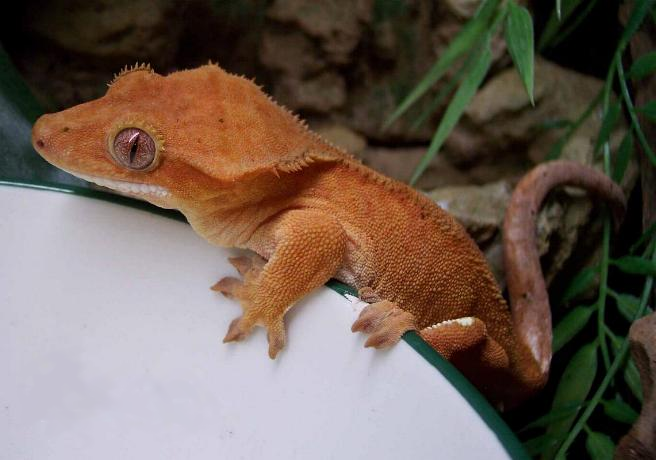 Please see Part 1 of this article for information on an interesting newcomer to the pet trade, the Nosy Be Gecko (Uroplatus ebenaui). Today we’ll take a look at some related species and the gecko family in general.
Please see Part 1 of this article for information on an interesting newcomer to the pet trade, the Nosy Be Gecko (Uroplatus ebenaui). Today we’ll take a look at some related species and the gecko family in general.
Other Geckos in the Genus Uroplatus
All 12 species that have been assigned to the genus Uroplatus, collectively known as “Leaf-Tailed Geckos”, are endemic to Madagascar and considered threatened due to extensive deforestation. Cryptic colors, nocturnal ways and arboreal habitats render it likely that other species await discovery…hopefully before they disappear forever.
The largest Leaf-Tailed Gecko, Uroplatus fimbriatus, reaches 7.6 inches in length and gapes widely to display its bright red tongue when disturbed. More than one neophyte zookeeper has called in a veterinarian to examine the apparently injured tongue upon first observing this display!
Leaf-Tailed Geckos bear an uncanny resemblance to dead leaves or bark, with the tails of some species sporting holes and irregularities that seem to have been chewed by insects. They also adopt poses and movements that heighten their camouflaging coloration and body form – the Nosy Be Gecko, for example, can hang head down from a branch in near-perfect mimicry of a dead leaf.
The eyelids of Leaf-Tailed Geckos are fused to form a protective, immobile covering known as the brille. Leaf-tailed Geckos use their tongues to clean the brille.
Gecko Diversity
The 1,180+ species of geckos described thus far comprise the second largest lizard family, the Gekkonidae (the largest family, the Scincidae, or skinks, boasts over 1,200 members). New species are being discovered with regularity – several just this month (June, 2010, please see article below). Geckos are found throughout much of the world, and reach their greatest diversity in desert, tropical and sub-tropical habitats.
Geckos range in size from the various Shaerodactylus species, some of which are full grown at 1.2 inches in length, to the New Caledonian Giant Gecko (Rhacodactylus leachianus), a bulky creature that tops out at nearly 15 inches. Other species, now considered extinct but which some folks believe may still survive in Madagascar, reached 24 inches in length.
People-Oriented Geckos

A number of small species, known collectively as “House Geckos” (Hemidactylus spp.), follow human habitation and are widely transplanted. Several, including the Mediterranean House Gecko, H. turcicus, (please see photo) are well-established in the Southeastern USA. The nocturnal House Geckos, invariably more common in and around homes than in more “natural” surroundings, ambush moths and beetles drawn to lights.
Because of their easy accessibility and interesting ways, House Geckos have been studied in detail and have revealed much of interest concerning territoriality and other types of behavior.
Further Reading
Article describing new Geckos recently uncovered in West Africa.
Cincinnati Zoo video of Leaf Tailed Geckos showing amazing camouflage abilities.
House Gecko image referenced from wikipedia and originally posted by Hexasoft
 That Reptile Blog – Reptile, Amphibian and Exotic Pet Care and Information
That Reptile Blog – Reptile, Amphibian and Exotic Pet Care and Information


